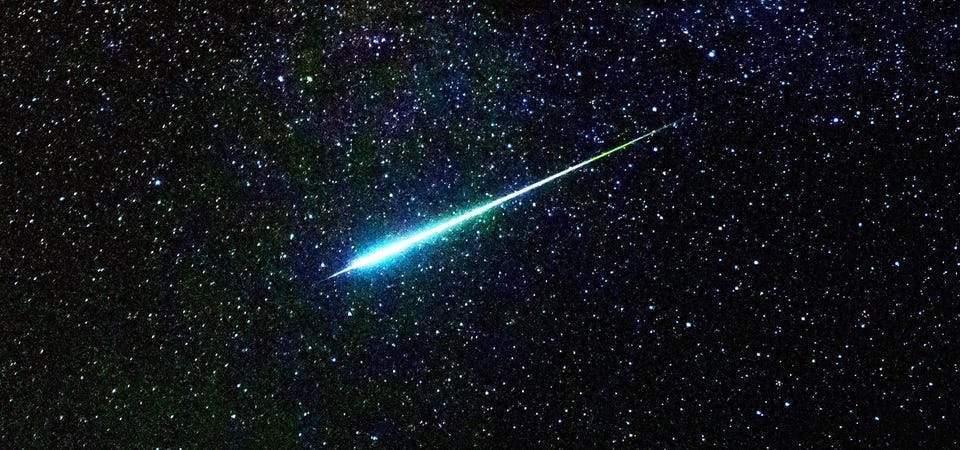Science The Perseids Meteor Shower Begins Now. Here’s Why To Avoid The Peak Night Jamie Carter Senior Contributor Opinions expressed by Forbes Contributors are their own. I inspire people to go stargazing, watch the Moon, enjoy the night sky New! Follow this author to improve your content experience.
Got it! Jul 16, 2022, 09:00pm EDT | Share to Facebook Share to Twitter Share to Linkedin A meteor streaks across the Milky Way during the Perseid meteor shower of 2016 Getty This weekend the world’s most famous annual meteor shower, the Perseids, begin falling. The “peak” night isn’t until mid-August, but from tonight if you see a “shooting star” streaking across the night sky from the north-west it’s most likely a Perseid. Known for being both colorful and for having bright, persistent trails, Perseids can number as high as 100 per hour, though typically you can see about 50 per hour.
It’s one of the reasons millions of stargazers plan a a special camping trip for the peak night. However, in 2022 that’s not a very wise idea. There are other factors at play that make this year’s Perseids meteor shower less likely to impress around the peak.
So it’s best to ignore the many (many) articles online that say you should go camping or otherwise find dark skies on August 11/12—the peak night—because that’s simply not true in 2022. Here’s everything you need to know about this year’s Perseid meteor shower—and why you should consider going to see it before the “best” night: What and when is the Perseid Meteor Shower? The Perseid meteor shower is the year’s most popular display of “shooting stars. ” Active between July 7 and August 24 and peaking on August 12/13, 2022.
Best seen from the northern hemisphere, this time of year is also the best for camping, and the most popular time of year for people to be in national parks, and in the outdoors generally. The Perseid meteor shower is caused by Comet Swift-Tuttle, which last passed through the solar system in 1992 on its 133-years long orbit of the Sun. When is August’s full ‘Sturgeon Moon?’ Sadly the full “Sturgeon Moon” rises on .
. . Thursday August 11, 2022.
Why “sadly?” The Moon is the biggest light-polluter of all and when it’s full or thereabouts it bleaches the night sky significantly and is “up” almost all night long. Right on peak Perseids night! Double whammy! MORE FOR YOU New Research Finds A Connection Between Domestic Violence And These Two Personality Disorders This Scientist Helps Andean Forests And Ecuador’s Women In STEM Exceptional Fossil Preservation Suggests That Discovering Dinosaur DNA May Not Be Impossible In fact the Moon will be so bright that it will render the peak night of the Perseids meteor shower rather insignificant. Your eyes just won’t see the faint meteors, meaning that “100 shooting stars per hour” promise will be spectacularly broken.
You may see one or two particularly bright meteors on the peak night, but that’s about it. The best times to see the Perseid Meteor Shower in 2022 To successfully see shooting stars you want a dark sky. That means a moonless sky after midnight.
Such a thing is only on offer between Last Quarter Moon—when the Moon rises after midnight—to a few nights after New Moon, when a crescent Moon sets before midnight. That’s a period of about 11 nights that this year falls between July 20 and July 31. Or, after the full Moon is out of the night sky, which is from about August 21 when it will rise well after midnight.
Since July 20 is rather too close to the beginning of the Perseid meteor shower, you should try to look for them closer to July 31. In fact, the nights of July 29/30/31 are probably the best time to look for shooting stars not only because the dark sky/predicted shooting stars ratio will be at the highest for the Perseids, but also because that night is also the peak night for the Delta Aquarids meteor shower. Another less good time to see the Perseids meteor shower will be after the full Moon when our satellite will be rising after midnight.
That’s going to be the nights of August 21/22/23, by which time the Perseids activity will be rapidly waning. They cease completely by September 1, 2022. However, the Perseids is a display that gradually waxes to the peak night then wanes quickly, so it’s July 29/30/31 when you should try for Perseids (and Delta Aquarids).
What is the Delta Aqaurid Meteor Shower? It’s another annual meteor shower. It’s best seen from the southern hemisphere. However, if you are at reasonably low latitudes you may see some of its 20 or so “shooting stars” per hour.
Add that to the waxing Perseids meteor shower and its peak nights—July 29/30/31—are the best nights this summer to see “shooting stars. ” Wishing you clear skies and wide eyes. Follow me on Twitter or LinkedIn .
Check out my website or some of my other work here . Jamie Carter Editorial Standards Print Reprints & Permissions.
From: forbes
URL: https://www.forbes.com/sites/jamiecartereurope/2022/07/16/the-perseids-meteor-shower-begins-now-heres-why-to-avoid-the-peak-night/



